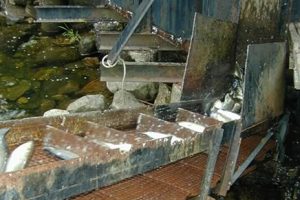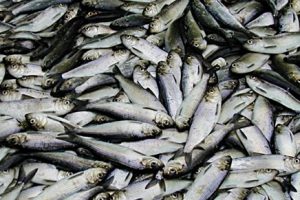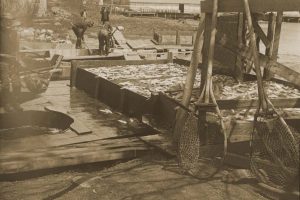Harvesting alewives is an integral part of spring in Damariscotta Mills. After the first week of the run, a time set aside for the first and strongest alewives to ascend the fish ladder to spawn, harvesting begins. Harvesting takes place 5 days a week, morning and evening, as long as plenty of fish are counted entering Damariscotta Lake to spawn. The harvested alewives are used primarily as lobster bait and increasingly as halibut bait. A few bushels are smoked by Mulligan’s Smokehouse and sold for human consumption.
As it has been for centuries, the fishery at Damariscotta Mills is managed jointly by the towns of Nobleboro and Newcastle. Damariscotta Mills is one of only about 20 sites in Maine where alewife harvesting is still in undertaken. Each year, the towns submit a harvest plan to the Maine Department of Marine Resources. This plan details when the harvest will begin and end for the season, which days of the week it will be operational, and who can harvest the fish. The harvesting plan also outlines conservation measures the towns will take that are critical to protecting the resource, including the collection of scale samples from 100 Alewives for study by the Maine Department of Marine Fisheries (MDMR), the protection of fish returning from their spawning grounds (run-backs), and the prevention of harvesting for a week once the fish arrive so the run can get established.
Harvesting takes place twice a day — at 5am and again at 4pm Monday through Friday from roughly the middle of May through the first week of June. The “dippers” and trough, Damarisotta Mills’ harvesting set-up, is the same gear that was designed and built in the late 1950s. Each harvest session lasts between 2 and 3 hours, the time dependent on the number of fish available to harvest and the demand for fish at that particular time. Fish are only harvested if there ae orders for them so no more alewives are taken than can be immediately used. Visitors are always welcome to check out the harvesting operation, and the harvesters are happy to answer questions.
Alewives from Damariscotta Mills are sold to lobstermen from the nearby ports of South Bristol, Boothbay and Pemaquid and also to lobstermen that travel from as far away as Orr’s Island, Mount Desert, and Vinalhaven. Damariscotta Mills alewives are sold on a first-come first-served basis, which prompts some lobstermen to arrive the evening before the bait is needed and to spend the night in their trucks to ensure a good place in the line. The lobster industry is one of Maine’s largest industries and it’s vital to the financial wellbeing of the state. Alewives provide a critical local source of bait in the spring, a time when bait is especially hard to find or particularly expensive. While some lobstermen use Damariscotta Mills alewives when they are fresh, others are freezing them for use later in the season. Damariscotta Mills alewives are very popular with fishermen and smokers alike because they are bigger than those at other runs, and because they have spent less time in freshwater when they are caught than alewives in many other runs.
For information pertaining to the harvesting of alewives in Damariscotta Mills, please contact the Fish Agent.
Mark Becker
Fish Agent, Towns of Nobleboro and Newcastle, Maine
Ph: 207 380 7996
E-mail: [email protected]
Harvest News
Harvesting has ended for 2023
June 2 As of this morning, Friday, June 2, harvesting alewives at Damariscotta Mills has ended for the year. We thank all the lobstermen and others who purchased fish for your business this year and in the past. We look forward to seeing you again next year!!!
First Harvest
May 15 Harvesting alewives for lobster bait began this morning at 5am and will continue Monday through Friday at 5am and 3pm. After such a strong beginning to the run, it was a bit disappointing this morning to see fewer fish moving into the fish ladder and harvesting area. The tide was quite low and […]
Harvesting set to begin Monday, May 15
May 10 Harvesting will begin on Monday, May 15 as long as the level of Damariscotta Lake subsides a bit. Recent rains raised the level of the lake more than a foot, which complicates the management strategies needed to attract and harvest alewives in the harvesting area. Look for updates here soon. The harvester and […]
Harvesting ended June 3
Thanks to all lobstermen and other buyers for a great year. We look forward to seeing you next year.

Harvesting alewives is an integral part of spring in Damariscotta Mills. After the first week of the run, a time set aside for the first and strongest alewives to ascend the fish ladder to spawn, harvesting begins. Harvesting takes place 5 days a week, morning and evening, as long as plenty of fish are counted entering Damariscotta Lake to spawn. The harvested alewives are used primarily as lobster bait and increasingly as halibut bait. A few bushels are smoked by Mulligan’s Smokehouse and sold for human consumption.
As it has been for centuries, the fishery at Damariscotta Mills is managed jointly by the towns of Nobleboro and Newcastle. Damariscotta Mills is one of only about 20 sites in Maine where alewife harvesting is still in undertaken. Each year, the towns submit a harvest plan to the Maine Department of Marine Resources. This plan details when the harvest will begin and end for the season, which days of the week it will be operational, and who can harvest the fish. The harvesting plan also outlines conservation measures the towns will take that are critical to protecting the resource, including the collection of scale samples from 100 Alewives for study by the Maine Department of Marine Fisheries (MDMR), the protection of fish returning from their spawning grounds (run-backs), and the prevention of harvesting for a week once the fish arrive so the run can get established.
Harvesting takes place twice a day — at 5am and again at 4pm Monday through Friday from roughly the middle of May through the first week of June. The “dippers” and trough, Damarisotta Mills’ harvesting set-up, is the same gear that was designed and built in the late 1950s. Each harvest session lasts between 2 and 3 hours, the time dependent on the number of fish available to harvest and the demand for fish at that particular time. Fish are only harvested if there ae orders for them so no more alewives are taken than can be immediately used. Visitors are always welcome to check out the harvesting operation, and the harvesters are happy to answer questions.
Alewives from Damariscotta Mills are sold to lobstermen from the nearby ports of South Bristol, Boothbay and Pemaquid and also to lobstermen that travel from as far away as Orr’s Island, Mount Desert, and Vinalhaven. Damariscotta Mills alewives are sold on a first-come first-served basis, which prompts some lobstermen to arrive the evening before the bait is needed and to spend the night in their trucks to ensure a good place in the line. The lobster industry is one of Maine’s largest industries and it’s vital to the financial wellbeing of the state. Alewives provide a critical local source of bait in the spring, a time when bait is especially hard to find or particularly expensive. While some lobstermen use Damariscotta Mills alewives when they are fresh, others are freezing them for use later in the season. Damariscotta Mills alewives are very popular with fishermen and smokers alike because they are bigger than those at other runs, and because they have spent less time in freshwater when they are caught than alewives in many other runs.
For information pertaining to the harvesting of alewives in Damariscotta Mills, please contact the Fish Agent.
Mark Becker
Fish Agent, Towns of Nobleboro and Newcastle, Maine
Ph: 207 380 7996
E-mail: [email protected]
Harvest News
Harvesting has ended for 2023
June 2 As of this morning, Friday, June 2, harvesting alewives at Damariscotta Mills has ended for the year. We thank all the lobstermen and others who purchased fish for your business this year and in the past. We look forward to seeing you again next year!!!
First Harvest
May 15 Harvesting alewives for lobster bait began this morning at 5am and will continue Monday through Friday at 5am and 3pm. After such a strong beginning to the run, it was a bit disappointing this morning to see fewer fish moving into the fish ladder and harvesting area. The tide was quite low and […]
Harvesting set to begin Monday, May 15
May 10 Harvesting will begin on Monday, May 15 as long as the level of Damariscotta Lake subsides a bit. Recent rains raised the level of the lake more than a foot, which complicates the management strategies needed to attract and harvest alewives in the harvesting area. Look for updates here soon. The harvester and […]
Harvesting ended June 3
Thanks to all lobstermen and other buyers for a great year. We look forward to seeing you next year.




